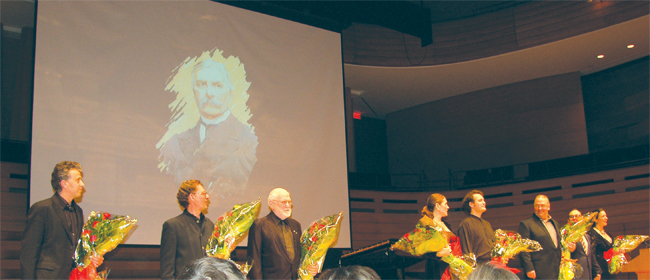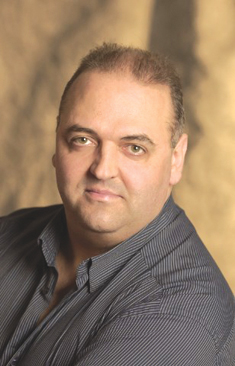
Lysenko,
Hunka and the Ukrainian Art Song
By Wasyl Sydorenko
One of the reasons why I am
writing this review in English is because the term art song has no
Ukrainian-language equivalent. This may come as a surprise since Ukrainian
composers have been writing art songs for nearly 150 years. And yet, there is
no Ukrainian word or phrase that describes this genre – one of the highest
forms of vocal art in European music.
In the Austro-German
tradition, the art song is known as the Lied, and in French as a mlodie.
In Ukrainian, the following terms have been used – , , , or
– with the last one coming closest to the semantic meaning of the term,
but without capturing its essence. Basically, an art song is a classical
composition that combines voice(s) and piano as partners in a musical setting
of poetry. The voice is not unlike an instrument and the accompaniment is not
unlike a soloist. Both combine to create a total musical experience.
During the 19th century,
For the next 25 years,
Lysenko continued, almost exclusively, to set the poetry of Shevchenko to
music. During this time, he attempted to create a Ukrainian version of the art
song based on compositional techniques and melodic elements derived from
Ukrainian folk songs and dumy. How successful he was is still a matter
of debate among musicologists and music-lovers.
In 1893, with the
composition of his song cycle to texts by Heinrich Heine, Lysenko all but
turned his back on Shevchenko and began setting to music the poetry of
contemporary Ukrainian writers – I. Franko, L. Ukrainka, O. Oles, etc.
Musically, too, there was a noticeable shift away from the folk song as Lysenko
began to imitate German composers and explore more modern styles of
composition.
There is a lot about Mykola
Lysenko that we do not understand. As a composer, he has been mythologized to a
point where we can no longer see him as he truly was. But, he was not the
father of classical music in
Nevertheless, Lysenko
composed more than 120 art songs and influenced almost every other Ukrainian
composer that followed him. This, indeed, is one of his most important
legacies. And yet, for more than a century, Lysenko’s art songs remained either
unpublished or unperformed. The publication of his collected works in the 1950s
failed to encourage musicians to explore this legacy. If concert programs were
strictly controlled by censors in Soviet Ukraine, why weren’t Lysenko’s art
songs performed by singers in the Diaspora?
 Without a performance
tradition or practice, it is not surprising that Lysenko’s oeuvre of art
songs baffled many a singer, including opera baritone Pavlo Hunka when he first
discovered them. Indeed, these were not arrangements of folk songs or salon
romances; these were concert hall art songs. Pavlo promised his father that one
day he would perform them and that the whole world would hear the beauty of the
Ukrainian art song.
Without a performance
tradition or practice, it is not surprising that Lysenko’s oeuvre of art
songs baffled many a singer, including opera baritone Pavlo Hunka when he first
discovered them. Indeed, these were not arrangements of folk songs or salon
romances; these were concert hall art songs. Pavlo promised his father that one
day he would perform them and that the whole world would hear the beauty of the
Ukrainian art song.
And so, Pavlo Hunka, the
Artistic Director of the Ukrainian Art Song Project (UASP), has devoted
his life to rediscover and promote world-wide the art songs of Ukrainian
composers, and to demonstrate that they are indeed part of the European
tradition of classical vocal music. The project has generated the term , which has been used by
After more than a decade of
intense preparation and collaboration with other performers, musicologists,
researchers, literary specialists, volunteers and sponsors, the art songs of
Mykola Lysenko were finally launched at a concert in Koerner Hall at the Royal
Conservatory of Music in
The concert première
of Lysenko’s art songs should go down in history as one of the greatest
achievements in Ukrainian classical music. Pavlo Hunka was assisted by fellow
singers Monica Whicher, Krisztina Szab, Russell Braun, pianist Albert Krywolt,
cellist Roman Borys and flautist Julie Ranti. These are but a few of the names
that appear on the recordings, which include: Isabel Bayrakdarian, Allyson
McHardy, Elizabeth Turnbull, Benjamin Butterfield, Michael Colvin, Robert
Gleadow, Mia Bach, Serouj Kradjian, and Douglas Stewart.
Canadian broadcaster Stuart
Hamilton was the host, Melanie Turgeon introduced the project’s online music
library (www.uasp.ca), the Chair of the Executive Committee Lesia Babiak
thanked all those who contributed to the project, and chief fundraiser William
Zyla thanked all the donors and sponsors. The list of names is long and
impressive. A special tribute was offered in honour of the late Richard
Bradshaw, Artistic Director of the Canadian Opera Company, for his support of
the project.
Not enough can be said
about the actual performance of Lysenko’s art songs. To create a performance
practice where none existed, especially one conforming to European tradition,
was no mean feat. This proves that Lysenko’s art songs do belong to the
classical tradition of European music. The interpretation of each art song was
remarkably insightful. The Ukrainian diction was nearly impeccable. The
renditions were pleasing to both the native and non-Ukrainian listener, and
musically convincing to any fan of vocal art. Truly, a job well done!
Roman Hurko returned as the
producer of the UASP’s Lysenko album. The recordings have a bright and
intimate sound, perfect for the genre. They are accompanied by a 207-page book
with annotations by Dagmara Turchyn and Wasyl Sydorenko. The 124 tracks of
songs are organized by theme into 6 CDs: Nature, Love, Fate,
A Historical Theme, A Philosophical Theme, and The Song Cycle
“A Poet’s Love”. The album is a milestone of performance practice and the
beginning of a new chapter in Ukrainian musicology. For the first time,
classical music lovers, students of Ukrainian music history, and performers
around the world can appreciate the creative genius of Mykola Lysenko. Thank
you, Pavlo, for your vision and your determination to see this stage of the UASP
through to completion. Bravo and encore!
Wasyl Sydorenko is a
musicologist and composer in Toronto,
PHOTOS
1 - L. to R.: Roman Borys, Albert Krywolt, Stuart Hamilton,
Krisztina Szabó, Russell Braun, Pavlo Hunka, Roman Hurko and Monica Whicher
after performance of Mykola Lysenko Ukrainian
Art Song, Koerner Hall, Royal Conservatory of Music, Toronto
2 - Pavlo Hunka